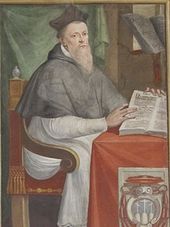Aegidius de Viterbo
Aegidius de Viterbo , also Egidio da Viterbo OESA , German Aegidius von Viterbo (* around 1469 in Viterbo , Italy ; † November 12, 1532 in Rome ), was a cardinal , theologian and humanist .
Life
The Antonini, Aegidius' parents, were not wealthy. Therefore he entered the Augustinian order in June 1488 . After studying with the Augustinians in Viterbo, he became a doctor of theology. In 1506 he was appointed vicar of the Augustinians by the Pope when the prior of the order died . Sponsored by Pope Julius II , he was elected Prior General three times in a row , namely in 1507, 1511 and 1515. In addition to the later episcopal dignity of Viterbo, other benefits were granted to him.
Aegidius took part in the Fifth Lateran Council in Rome in 1512 , where he was praised in church history for his bold and serious remarks at the opening of the council and later represented the concerns of religious. Pope Leo X elevated him to cardinal in 1517 and shortly thereafter appointed him cardinal priest with the titular church of San Bartolomeo all'Isola . In 1523 he became Bishop of Viterbo , and in 1524 the Pope gave him the title of Latin Patriarch of Constantinople , which, however, had only been given for a long time in order to maintain the claim to the Ecumenical Patriarchate of Constantinople established after the 4th Crusade . Leo X sent Giles as legate to the Spanish King Charles, who soon as V. Karl the Emperor Holy Roman Empire should be.
Aegidius advocated a real reform of the church and sent Pope Hadrian a promemoria . He was widely appreciated in the College of Cardinals and some contemporaries suspected that he would succeed Pope Clement VII .
Aegidius studied Hebrew with Elijah Levita , who stayed at his house with his family for ten years after leaving Padua . During this time Levita worked as a teacher of the Roman notables for the customs and teachings of the Jews. Levita's work Baḥur , published in Rome in 1518, is dedicated to Aegidius, as is his work Concordancia from 1521.
Little has been preserved of Aegidius' writings, which covered almost all areas of knowledge at the time, partly because he only had a few printed, partly because a large part was destroyed at the Sacco di Roma in 1527. In recent times, numerous art historians assume that the theological-philosophical pictorial program of the Raphael frescoes in the Stanza della Segnatura of the Vatican was decisively inspired by him.
literature
- Germana Ernst, Simona Foà: Egidio da Viterbo. In: Fiorella Bartoccini (ed.): Dizionario Biografico degli Italiani (DBI). Volume 42: Dugoni – Enza. Istituto della Enciclopedia Italiana, Rome 1993.
- Anna Maria Voci-Roth: Aegidius of Viterbo as an order and church reformer. In: Hartmut Boockmann, Bernd Moeller , Karl Stackmann (eds.): Life lessons and world designs in the transition from the Middle Ages to the modern age. Politics - Education - Natural History - Theology. Report on colloquia of the commission to research the culture of the late Middle Ages 1983 to 1987 (= treatises of the Academy of Sciences in Göttingen: philological-historical class. Volume III, No. 179). Vandenhoeck & Ruprecht, Göttingen 1989, ISBN 3-525-82463-7 , pp. 520-538.
Web links
- Literature by and about Aegidius de Viterbo in the catalog of the German National Library
- Viterbo, OESA, Egidio there. In: Salvador Miranda : The Cardinals of the Holy Roman Church. ( Florida International University website), accessed December 6, 2016.
Individual evidence
- ^ Heinrich Pfeiffer : The sermon of Egidio da Viterbo about the golden age and the Stanza della Segnatura. In: JA Schmoll called Eisenwerth, Marcell Restle, Herbert Weiermann (eds.): Festschrift Luitpold Dussler. Munich-Berlin, Deutscher Kunstverlag, 1972, pp. 237-254; Ders .: On the iconography of Raphael's Disputa : Egidio da Viterbo and the Christian-Platonic conception of the Stanza della Segnatura. Rome, Università Gregoriana Editrice, 1975; Gavino Polo: Egidio da Viterbo e Raffaello. (PDF; 75 kB) In: Biblioteca e Società. Viterbo 1982, pp. 21-22.
| personal data | |
|---|---|
| SURNAME | Aegidius de Viterbo |
| ALTERNATIVE NAMES | Egidio da Viterbo |
| BRIEF DESCRIPTION | Cardinal, theologian and humanist |
| DATE OF BIRTH | around 1469 |
| PLACE OF BIRTH | Viterbo , Italy |
| DATE OF DEATH | November 12, 1532 |
| Place of death | Rome |

